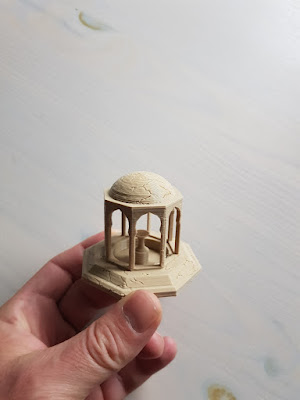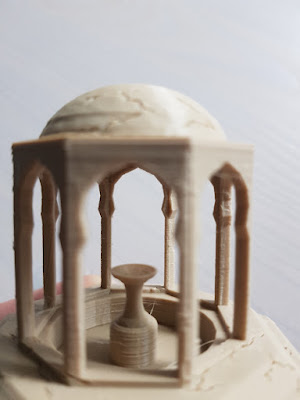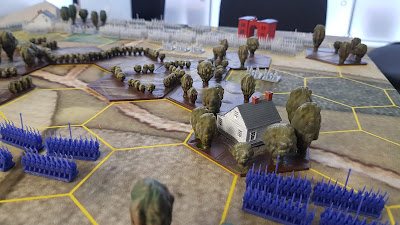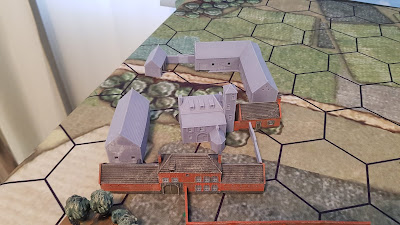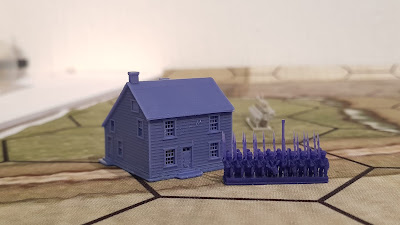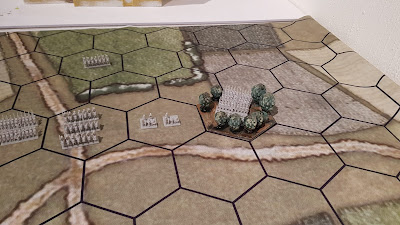Neuere Innovationen im Hobby werden häufig, wie auch
sonst im Leben, zunächst einmal kritisch beäugt.
Als vor Jahren die ersten 28 mm Figuren in Plastik herauskamen, schrien die Hobbyisten regelrecht auf.
„Was soll das??? Das ist der Tod unserer geliebten Zinnfiguren!!!“
Es gab sogar viele Sammler und Spieler, die Plastik an sich verdammten.
Da ging es nicht um die Figuren, deren Modellierung, deren Stil, deren Qualität, sondern allein um die Tatsache des verwendeten Werkstoffs.
Heute gehören die Plastikminis in 28 mm einfach zum Hobby dazu, sind weitflächig akzeptiert bzw. werden als „Multiposing“ Figuren sogar gefeiert, weil der Umbau, das Kitbashing viel einfacher ist, als bei Zinn.
Es gibt aber weiterhin Menschen, die diese Minis ablehnen.
Darin sehe ich auch gar kein Problem.
Aber häufig wird da etwas pauschal verdammt.
Diskussionsgrundlage? Konsensfindung? Fehlanzeige.
Diese Einstellung gilt aber nicht nur für Figuren.
Als vor Jahren die ersten 28 mm Figuren in Plastik herauskamen, schrien die Hobbyisten regelrecht auf.
„Was soll das??? Das ist der Tod unserer geliebten Zinnfiguren!!!“
Es gab sogar viele Sammler und Spieler, die Plastik an sich verdammten.
Da ging es nicht um die Figuren, deren Modellierung, deren Stil, deren Qualität, sondern allein um die Tatsache des verwendeten Werkstoffs.
Heute gehören die Plastikminis in 28 mm einfach zum Hobby dazu, sind weitflächig akzeptiert bzw. werden als „Multiposing“ Figuren sogar gefeiert, weil der Umbau, das Kitbashing viel einfacher ist, als bei Zinn.
Es gibt aber weiterhin Menschen, die diese Minis ablehnen.
Darin sehe ich auch gar kein Problem.
Aber häufig wird da etwas pauschal verdammt.
Diskussionsgrundlage? Konsensfindung? Fehlanzeige.
Diese Einstellung gilt aber nicht nur für Figuren.
Menschen im Hobby, die bestimmte Sachen per se ablehnen, kommen dann schon als Pauschalisten rüber.
Man hat halt seine eigene Meinung und rückt dann auch so gut wie nie davon ab.
Pauschalisten gibt es übrigens sowohl im Wargaming als auch in der Figurensammlerszene.
Meine drei Lieblingssprüche aus dem Kreis der Figurensammler sind diese:
„28 mm Figuren haben Wasserköpfe!!“
„15 mm Figuren wirken wie Gnome und haben Waffen wie Baumstämme!!“
„1/72 ist der einzig wahre Maßstab!“
Meine 3 Lieblingsgsprüche aus dem Kreis der Wargamer sind:
„Das ist 1/72!!!“ (Reicht schon als Verdammung an sich).
„Kann man das von innen bespielen?“
„Da sind Druckrillen!!“
Ich könnte jetzt noch viel mehr aufzählen, möchte ich aber nicht.
Vor allem der letzte Spruch hat es mir angetan, weil wir da nämlich bei einer neuen Innovation sind, die sich immer mehr verbreitet, die aber auch Meinungen spaltet, ähnlich wie DAMALS bei den Plastikminis.
Ich rede vom 3D Druck.
Viele von uns haben das Wort 3d Drucker schon gehört.
Aber viele denken dabei nur an die FDM Drucker, also die Drucker, die quasi Schichten von Plastik dünn übereinander auftragen.
Das ergibt dann die vielgeschmähten Druckrillen.
Ich habe mich oft gefragt, warum manche Sammler diese produktionsbedingte Eigenart so stört, weil Sie MIR gar nicht so auffällt.
Mittlerweile habe ich es verstanden.
Es geht darum, WIE wir ein Modell betrachten.
Es ist noch gar nicht lange her, da hatten wir erneut in einem Sammlerkreis über dieses Thema gesprochen. Online.
Während des Gesprächs bin ich dann aufgestanden, zu meinem Regal gegangen und habe mir diesen Brunnen hier angeschaut.
Ich habe ihn so gesehen.
Dann habe ich aber kurz innegehalten, den Brunnen näher ans Auge geführt, mal unter die Lupe gehalten, und dann, ja dann habe ich es verstanden.
So sehen ihn eben andere.
Es liegt einfach daran, ob wir ein gedrucktes Gebäude aus der berühmten „Armlängensicht“ (eine Figur muss auf Unteramlänge betrachtet, gut aussehen) oder aus der „Makrosicht“ betrachten, sie also vergrößern oder sehr nahe ans Auge führen.
Da ist es einfach so, dass wir Menschen einen unterschiedlichen Ansatz haben.
Wer sich auf die Druckrillen konzentriert, sieht sie auch aus 50cm Entfernung, wem sie egal sind, der sieht sie noch nicht auf 10cm.
Zum Glück kann man bei vielen Drucken diese Rillen durch pure Bemalung und ein paar Hilfsmittel bearbeiten. Auch MDF Gebäude kann man so aufpimpen, dass die flache Struktur nicht mehr auffällt.
Im Druckbereich gibt es allerdings auch eine Alternative, wenn ich auf diese Druckrillen verzichten will.
Sie können einen Resindrucker verwenden.
Was machen jetzt die?
„Bei Resin-Druckern wird ein zähflüssiges Harz mit UV-Licht belichtet, welches dann schichtweise aushärtet. Die Technik hat eine höhere Auflösung, ermöglicht damit ein deutlich genaueres Druckbild und ist zuverlässiger in der Handhabung.“ So der entsprechende Google Eintrag.
Diese Drucker erzeugen dann auch keine Druckrillen, und für die meisten Hobbyisten würden, die dann auch für ihr Hobby ausreichen.
Mit Resindruckern kann ich Figuren, Fahrzeuge, Gelände, Zubehör, aber auch Gebäude bis zu einem Maßstab von ca. 1/72 problemlos ausdrucken.
Für die sogenannten kleinen Maßstäbe, 6 mm bis 15 mm, sind sie schon als ideal zu betrachten.
Na und die Investition, die Sie tätigen müssen, hält sich echt in Grenzen.
Das Modell hier rechts im Bild kostet gerade einmal 179,- € und gehört zu der Druckerfamilie mit denen die Figuren und Gebäude in diesem Bericht auch ausgedruckt wurden.
Wenn Sie also beabsichtigen in den kleinen Maßstäben groß
einzusteigen, dann sollten Sie sich mit dieser neuen Technik einmal vertraut
machen.
Den Anschaffungspreis haben Sie da schnell raus.
Für größere Maßstäbe empfehlen die Spezialisten aber weiterhin FDM Drucker.
Sie sind im Druck kostengünstiger, bieten ein größeres Druckbett zum günstigeren Preis, und sind auch umweltfreundlicher, weil Resin doch für Mensch und Umwelt giftig ist.
Man muss da schon vorsichtiger mit umgehen als mit einer Spule Filament, was ja nichts anderes als Plastik ist bei einem 3D Drucker.
Wie genial aber die Miniaturen und Häuser wirken, können Sie hier im Bericht sehen.
Selbst die Großaufnahmen sind absolut überzeugend.
Immer daran denken!!!
Sowohl die Waterloo- als auch die ACW Häuser sind in 6 mm gedruckt.
Die Details sprechen für sich.
Den Anschaffungspreis haben Sie da schnell raus.
Für größere Maßstäbe empfehlen die Spezialisten aber weiterhin FDM Drucker.
Sie sind im Druck kostengünstiger, bieten ein größeres Druckbett zum günstigeren Preis, und sind auch umweltfreundlicher, weil Resin doch für Mensch und Umwelt giftig ist.
Man muss da schon vorsichtiger mit umgehen als mit einer Spule Filament, was ja nichts anderes als Plastik ist bei einem 3D Drucker.
Wie genial aber die Miniaturen und Häuser wirken, können Sie hier im Bericht sehen.
Selbst die Großaufnahmen sind absolut überzeugend.
Immer daran denken!!!
Sowohl die Waterloo- als auch die ACW Häuser sind in 6 mm gedruckt.
Die Details sprechen für sich.
Ich selbst habe noch klassisch gegossene Resinhäuser in 6 mm.
Aber die kommen an diesen Detailgrad definitiv nicht ran, und dass obwohl sie aus der gleichen Herstellerschmiede stammen.
Die damaligen Silikonformen von Jens Najewitz waren schon gut, aber was die Drucker jetzt raushauen, ist definitiv eine Steigerung.
Ich denke, es wird immer wichtiger sich mit diesem Thema im Hobby zu befassen.
Nach meiner Meinung ist diese Entwicklung nicht mehr umkehrbar.
Den 3D Druckern gehört die Zukunft.
Die 3d files der Gebäude können Sie bei 3d printterain erwerben:
Musket and Bayonet era – 3dprintterrain
America – 3dprintterrain
When the first 28 mm plastic figures came out years ago, the hobbyists literally screamed.
"What’s that??? This is the death of our beloved tin figures !!! "
There were even many collectors and wargamers who condemned plastic itself.
It wasn't about the figures, their modeling, their style, their quality, but solely about the fact of the material used to produce them.
Today the plastic minis in 28 mm are simply part of the hobby, are widely accepted or are even celebrated as "multiposing" figures, because the conversion, the kit bashing, is much easier compared with tin miniatures.
Sometimes people reject certain things per se.
I will call them generalists.
By the way, there are generalists in both parts of the hobby: In Wargaming- and the figure collector scene.
My three favorite sayings from the circle of figure collectors are these:
"28 mm figures have water heads !!"
"15 mm figures look like gnomes and have weapons like tree trunks !!"
"1/72 is the only true scale!"
My three favorite sayings from the wargamers are:
"That's 1/72 !!!" (That's enough as a damnation in itself).
"Can you play it from the inside?"
"You see the layers at printed models !!"
I could list a lot more now, but I don't want to.
I was particularly impressed by the last slogan, because we see a new innovation that is spreading more and more, but which also divides opinions, similar to what happened back then with the plastic minis.
I'm talking about 3D printing.
Many of us have heard the word 3d printer.
But many only think of the FDM printers, i.e. the printers that apply layers of plastic thinly on top of each other.
And many collectors hate these layers.
I have often asked myself why some collectors are so bothered by this production-related peculiarity, because I don't notice it so much.
I've got it now.
It's about HOW we look at a model.
It wasn't long ago that we spoke about this subject again in a group of collectors. We met at Skype.
During the conversation I went to my shelf and looked at this printed fountain.
I saw it like that.
But then I paused for a moment, brought the fountain closer to my eye, looked at it once under a magnifying glass, and then, yes, then I understood.
That's how others see the model.
It is simply a matter of whether we are looking at a printed building from the famous “arm's length view” (a figure has to look good when viewed from below) or from the “macro view”, ie enlarge it or bring it very close to your eye.
It's just that we humans have a different approach.
If you concentrate on the layers, you can see them from 50cm away, whoever doesn't care about them will not see them at 10cm yet.
Fortunately, with many prints you can work on these layers by simply painting and a few tooling.
But, if you are one of the guys, who concentrated himself on the layer structure, what can you do?
Just use a resin printer.
“With resin printers, a viscous resin is exposed to UV light, which then hardens in layers. The technology has a higher resolution, enables a much more precise print image and is more reliable to use. ” (so the corresponding Google entry).
These printers then do not produce any visible layers, and for most hobbyists this type of printer would be sufficient for their hobby.
With resin printers you can easily print out figures, vehicles, terrain, accessories, but also buildings up to a scale of approx. 1/72.
For the so-called small scales, 6 mm to 15 mm, the printers can be regarded as ideal.
Well, the investment that you have to make is really limited.
This model costs just 179, - € and belongs to the printer family with which the figures and buildings in this report were also printed out.
So if you intend to get started on a small scale, then you should familiarize yourself with this new technology.
For larger scales, however, the specialists still recommend FDM printers.
The printers are cheaper, offer a larger print bed at a lower price, and are also more environmentally friendly because resin is toxic to humans and the environment.
You have to be more careful with it than with a spool of filament, which is nothing more than plastic in a 3D printer.
How ingenious the miniatures and houses look, you can see here in the report.
Even the close-ups are absolutely convincing.
Always remember!!!
Both the
The details speak for themselves.
I myself still have classically cast resin houses in 6 mm.
But they definitely don't come close to this level of detail, even though they were bought from the same manufacturer.
The silicone molds from Jens Najewitz at the time were already good, but what the printers are now creating is definitely a step up.
I think it is becoming more and more important to deal with this topic in the hobby.
In my opinion, this development is no longer reversible.
The future belongs to 3D printers.
Buildings from the various
Musket and Bayonet era – 3dprintterrain
America – 3dprintterrain






